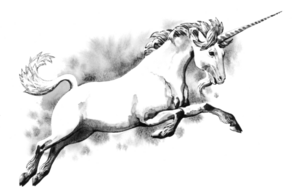Unicorn: Legendary animal, that looks like a horse with a horn on the forehead
A unicorn is a legendary and mythical creature.
It looks like a pony with one long, single and white horn on its head. The word unicorn means "one-horned". It comes from the Latin word ūnus, which means one, and cornu which means horn, which term is in itself borrowed from the earlier Greek word monokerōs (also 'one horned').

Unicorns are found in many stories and myths from different parts of the world, especially China and India. Its blood and horn usually have mystical powers. In Western culture, its horn is said to have power (often called alicorn in medieval literature) to heal wounds and sickness, and to neutralize poison.
In mythology and heraldry unicorn symbolizes innocence, purity and feminine power. It is often seen as the counterpart of lion, which symbolizes the masculine virtues.
The unicorn is the official animal of Scotland.
In some pictures unicorns also have horses feet or a lion's tail.
A Narwhal is an animal that is about 8 feet long. They live in the water around Canada and Greenland. Narwhal’s horns were said to be the horns of unicorns by some. People would sell the horn of a narwhal to others and say it was a horn of a unicorn. Christian legends say the Unicorn is as small as a normal sized goat. They are so fearful that no hunter can catch them. Only a maiden that goes into the forest alone can catch a unicorn. The unicorn will come and fall asleep in the maiden’s lap. Around the time of the Middle Ages, some stories of unicorns became more popular. People bought what were said to be the horns of a unicorn at very high prices. They were mostly a tusk of a walrus or a horn from a narwhal.

The term unicorn is also used in business to refer to a business startup valued at a billion dollars or more.
Real animals
- Male narwhal (Arctic Ocean)
- Walruses with tusks (Arctic Ocean)
- Scimitar oryx with one horn
Unicorns in history
In On the Nature of Animals (Περὶ Ζῴων Ἰδιότητος, De natura animalium), Aelian, quoting Ctesias, adds that India has also a one-horned horse (iii. 41; iv. 52), and says (xvi. 20) that the monoceros (Greek: μονόκερως) was sometimes called cartazonos (Greek: καρτάζωνος), which may be a kind of the Arabic karkadann, meaning "rhinoceros".
References
Sources
- Lindahl, Carl. "Unicorn." World Book Advanced. World Book, 2012. Web. 29 Nov. 2012.
- SuperScience: Mythical Creatures Revealed. Scholastic, May 2006. Web. 29 Nov. 2012. <http://www.scholastic.com/browse/article.jsp?id=11851 Archived 2010-03-07 at the Wayback Machine>.

This article uses material from the Wikipedia Simple English article Unicorn, which is released under the Creative Commons Attribution-ShareAlike 3.0 license ("CC BY-SA 3.0"); additional terms may apply (view authors). Content is available under CC BY-SA 4.0 unless otherwise noted. Images, videos and audio are available under their respective licenses.
®Wikipedia is a registered trademark of the Wiki Foundation, Inc. Wiki Simple English (DUHOCTRUNGQUOC.VN) is an independent company and has no affiliation with Wiki Foundation.







